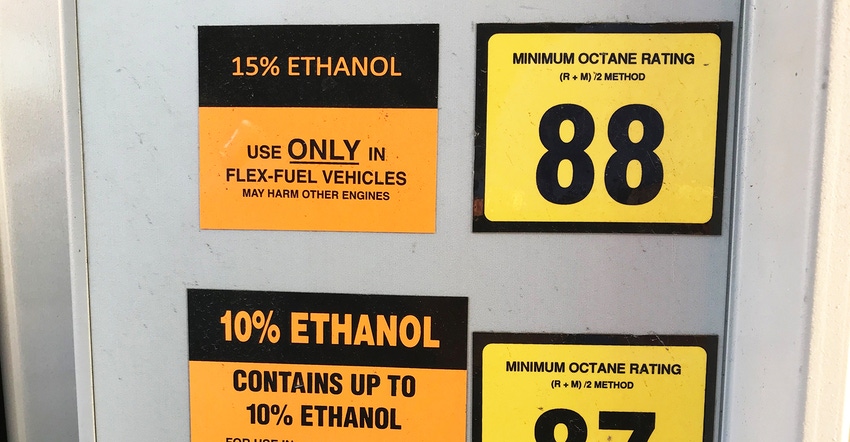October 22, 2018

The sticker on the fuel pump is clear. E15 is for flex-fuel vehicles, but nearly nine months out of the year that sticker is replaced with one that notes E15 is safe for vehicles manufactured after 2001. What gives? The answer lies in the concept of Reid vapor pressure, a measure of a fuel’s volatility, with regulations passed in 1990 regarding fuel; and given the recent announcement by the Trump administration, that’s about to change.
It’s a bit complicated, but Congress passed rules in 1990 as part of the Clean Air Act that allow sale of gasoline with 10% ethanol even though it boosts volatility — which is measured using the RVP standard. Most states are allowed 9 pounds for that standard, but E10 raises that to 10. Yet in 1992, E10 was exempted because adding ethanol to gasoline offers other environmental benefits.
Along comes E15 with a higher ethanol content, which is not included in that standard. And even though E15 has a slightly lower RVP than E10, it falls under a different standard and doesn’t get the waiver E10 does.
Over the past decade a growing list of independent retailers, including Kwik Trip, Sheetz, Thorntons, RaceTrac and others have started offering E15 at the pump. They’ve found that the higher-octane fuel — which can be sold at a lower price, thanks to current ethanol pricing — can be a popular product most of the year. Now back to that sticker.
Every June 1 (though the stickers may appear early, just so sites don’t miss the deadline), every one of those independent retails has to affix a label to its E15 dispensers, noting this is a product for flex-fuel vehicles — and after Sept. 15, that label can be changed back to one that notes E15 is safe for vehicles made after 2001. That label switch creates customer confusion and is also a challenge for the retailers who must affix labels on thousands of pumps each year.
Customer demand
But do customers want E15? “There are varying degrees of consumer interest in the product,” says Joel Hirschboeck, who had been Kwik Trip general manager of fuel procurement and market, but recently moved to GetGo. He shared Kwik Trip’s experience with the fuel. “They see the octane number and the price, and make a decision based on that.”
Many independent retailers don’t call the fuel E15, opting instead for names like Unleaded 88 or some other marketing term that notes the higher octane. But that sticker change did cause a challenge. Hirschboeck says consumers would be confused by a label that suddenly said the fuel they topped off with the week before was now only for flex-fuel cars. “We would get calls to our call-in number with questions, and we address them as they call,” he says. “And putting on those labels does have a cost.”
He noted that KwikTrip has 350 locations offering Unleaded 88, and each location has 10 pumps with two sides for applying stickers. That’s where costs add up.
Yet, retailers are seeing higher demand for E15 when it is added as a choice. Having the Trump administration make the move to make it a year-round fuel could open the door to more sales, too, as retailers can overcome some of that customer confusion.
Growth Energy has a program called Prime the Pump, which is a partnership that helps retailers promote use of E15. Two major retailers recently announced they have joined the program. The Iowa-based retailer Casey’s General Store came on stream and will look at adding the fuel to more than 500 locations over time. Cumberland Farms is the latest addition to the program, and the company will begin offering E15 to more than 120 of its stores in the Northeast.
In the Growth Energy announcement, Casey’s noted it will expand sale of the higher-ethanol-content fuel to potentially more than 500 of its locations over the next few years. In the announcement, Nathaniel Doddridge, Casey’s director of fuels, noted, “Since first rolling out E15, we’ve seen the benefit the biofuel blend offers — in terms of value for our customers and a competitive advantage for our business.”
At Cumberland Farms, David Masuret, senior vice president, petroleum and supply, notes that “as E15’s growth continued to accelerate, it became an obvious choice for us to make it available to our customers.”
Sharing the story
Growth Energy recently also fired up a new website focused on E15 and its benefits for the industry. The site talks about Unleaded 88 and works to answer consumer questions about the product. You can learn more at unl88.com.
More retailers are carrying the higher-ethanol-content fuel. Mike O’Brien, vice president of market development, Growth Energy, points out a long list of familiar names that now handle the fuel. And he’s been involved in efforts to promote not only E15, but also blender systems that would boost ethanol use for the 21 million flex-fuel vehicles on the market that can use higher blends like E85 (which include as much as 83% ethanol).
“E15 has the potential to boost ethanol demand and use by more than a billion gallons in a short time,” O’Brien says. “We have more retailers every day that are adding the ability to sell E15 at the pump.”
For farmers, anything that can boost demand for corn at a time when bins are full, and prices are low, boosts demand. And while corn makes ethanol, byproducts from ethanol production feed livestock. The news that E15 could become a year-round fuel offers promise of higher demand.
About the Author(s)
You May Also Like






